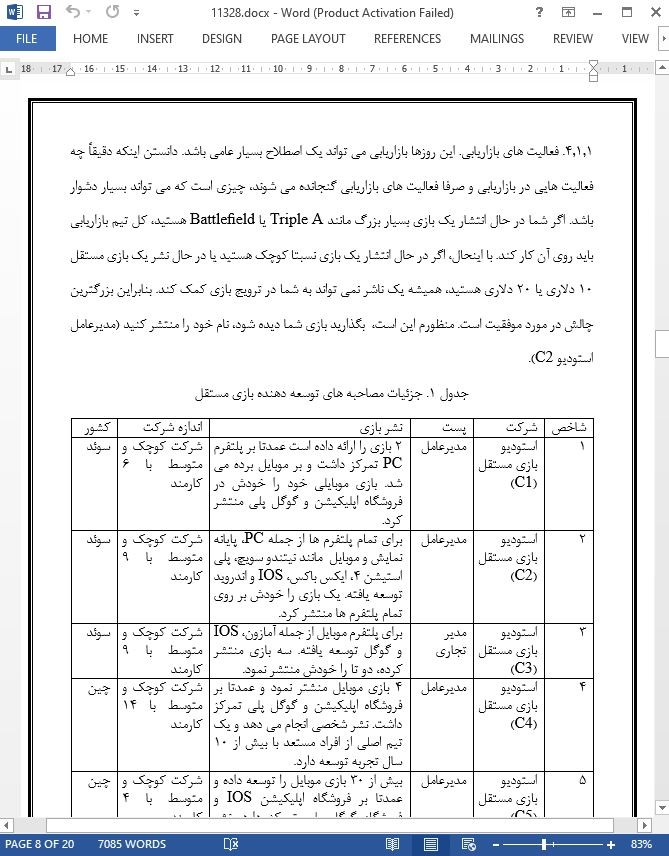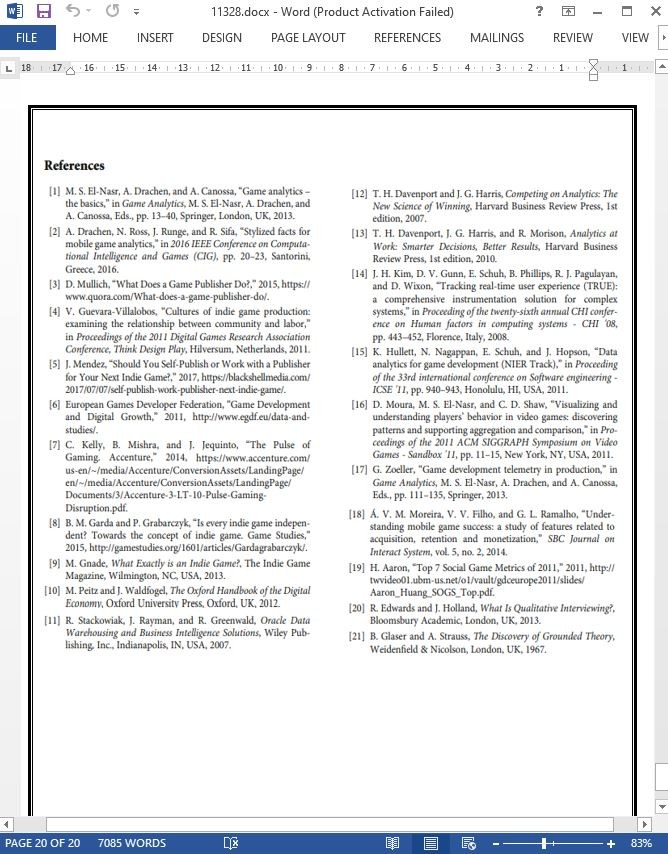
چالش های هوش کسب و کار برای نشر بازی مستقل
با توسعه مستمر صنعت بازی، تحقیق در حوزه بازی نیز بیشتر شده است. بسیاری از حوزه های میان رشته ای دانش و نظریه، برای ارتقاء توسعه صنعت بازی به کار رفته اند. تکنولوژی های هوش کسب و کار در توسعه بازی برای طراحی و بهینه سازی بازی استفاده می شود. با این وجود، تلاش های تحقیقاتی سیستماتیک کمی بر حوزه نشر بازی تمرکز داشته است، به ویژه درباره نشر بازی مستقل. در این مقاله داده های جمع آوری شده از مجموعه ای از مصاحبه ها با تعداد کمی توسعه دهندگان بازی مستقل را تحلیل میکنیم. نتایج نشان میدهند که بیشتر توسعه دهندگان بازی مستقل از هوش کسب و کار برای نشر شخصی بازی استفاده می کند، گرچه، سه چالش مهم شناسایی شده است: ابتدا، چگونه ترویج بازاریابی را انجام دهیم و بازده سرمایه گذاری را بهبود دهیم؛ دوم، چگونه داده های مربوط به نشر بازی را جمع آوری کنیم؛ و سوم، چگونه داده ها را تحلیل کنیم تا نشر شخصی بازی را هدایت کنیم. مصاحبه های ما نیز نشان می دهند که مدل کسب و کار به کار گرفته شده برای یک بازی به طور معناداری بر نقش تجزیه تحلیل بازی تاثیر می گذارد. این مطالعه تحقیقات مربوط به اینکه چگونه تحلیل های بازی را می توان برای نشر بازی، به ویژه نشر شخصی بازی مستقل به کار برد، توسعه می دهد.
1.مقدمه
هوش کسب و کار (BI) در توسعه بازی برای طراحی و بهینه سازی بازی به کار رفته است [1]. گرچه، تلاش های تحقیقاتی سیستماتیک کمی بر حوزه نشر بازی تمرکز داشته است، به ویژه درباره نشر بازی مستقل. در اصل این حوزه هنوز در دوران اولیه تکامل خود قرار دارد و دانش موجود نیز بسیار پراکنده است[2]. هدف ما شناسایی و اصلاح مشکلات عمده ای است که توسعه دهندگان بازی مستقل در نشر بازی خود با آن مواجه هستند. با این حساب، توسعهدهندگان بازی مستقل وظایف بسیار زیادی دارند[3]؛ آنها باید خودشان را مدیریت کنند. همچنین، با افزایش تعداد بازی های موبایلی، شاهد افزایش تعداد استودیوهای بازی مستقل هستیم. با این وجود؛ بیشتر استودیوهای بازی مستقل که در توسعه بازی شایستگی های زیادی دارند، فاقد تجربه کافی در زمینه نشر بازی هستند[4].
6. نتیجه گیری و تحقیقات آتی
تحقیق ما مبتنی بر مصاحبه ها با استودیو های بازی مستقل مختلف برای شناسایی شکافهای تحقیق بالقوه برای نشر بازی مستقل می باشد. گرچه تغییرات زنجیره ارزش بازی، نشر شخصی بازی مستقل را امکان پذیر ساخته است، چگونه توسعه دهندگان بازی مستقل کسب و کار نشر شخصی بازی را انجام می دهند، هنوز هم مشخص نیست. مجموعه مصاحبه هایی را با توسعه دهندگان بازی مختلف انجام دادیم تا چالشهای مهم نشر بازی مستقل را پیدا کنیم. بررسی مصاحبه ما نشان میدهد که با ظهور زنجیرههای ارزش بازی جدید توسعه دهندگان بازی مستقل توانستند خودشان کسب و کار نشر را مدیریت کنند. آنها از تکنولوژی های BI برای نشر شخصی بازی خود استفاده کردند، با این حال هنوز هم چالشهایی وجود دارد.
With the continuous development of the game industry, research in the game field is also deepening. Many interdisciplinary areas of knowledge and theory have been used to promote the development of the game industry. Business intelligence technologies have been applied to game development for game design and game optimization. However, few systematic research efforts have focused on the field of game publishing, particularly with regard to independent (indie) game publishing. In this paper, we analyse data collected from a set of interviews with small indie game developers. The results indicate that most of the indie game developers have already used business intelligence for game self-publishing, although three main challenges have been identified: first, how to conduct marketing promotion and improve the return on investment (ROI); second, how to collect game publishing data; and third, how to analyse the data in order to guide game self-publishing. Our interviews also reveal that the business model applied to a game significantly impacts the role of game analytics. The study expands and advances the research on how game analytics can be used for game publishing, particularly for indie game self-publishing.
1. Introduction
Business intelligence (BI) has been applied to game development for game design and game optimization [1]. However, few systematic research efforts have focused on the field of game publishing, particularly with regard to independent game publishing. In essence, the field is in its infancy and the available knowledge is heavily fragmented [2]. We aim to identify and remedy the primary problems faced by indie game developers during their game publishing. This means that indie game developers have many tasks [3]; they must manage themselves. Also, as more and more mobile games appear, we see an increasing number of indie game studios. However, most indie game studios that are competent at game development lack experience of game publishing [4].
6. Conclusion and Future Research
Our research is based on interviews with different indie game studios to identify the potential research gaps for indie game publishing. Although game value chain changes make indie game self-publishing possible, how indie game developers do the game self-publishing business is still unclear. We conducted a set of interviews with indie game developers to find out the main challenges for indie game publishing. Our interview study shows that with the emergence of new game value chains, indie game developers can handle the publishing business themselves. They have already used BI technologies for game self-publishing, but there are still challenges. The main challenges include how to conduct market promotion based on ROI data analysis, how to collect useful and valuable game data, and how to analyse these data and guide their game optimization and game self-publishing process.
1 مقدمه
2 آثار مربوطه
2.1 مدل کسب و کار بازی
2.2 بازی مستقل
2.3 نشربازی (منتشر کردن بازی)
2.4 هوش کسب و کار
2.5 منطق تجزیه و تحلیل بازی
3 روش تحقیق
3.1 طرح مصاحبه
3.2 آماده سازی مصاحبه
3.3 جمع آوری داده ها
3.4 تحلیل داده
4. نتایج
4.1 چالش های بازاریابی
4.2 چالش های جمع آوری داده ها
4.3 چالش های منطق تجزیه و تحلیل داده ها
4.4 نقش مدل کسب و کار
4.5 چالشهای مهم- خلاصه
5 بحث
6. نتیجه گیری و تحقیقات آتی
1. Introduction
2. Related Work
2.1. Game Business Model.
2.2. Indie Game
2.3. Game Publishing
2.4. Business Intelligence
2.5. Game Analytics
3. Research Method
3.1. Interview Design
3.2. Interview Preparation
3.3. Data Collection
3.4. Data Analysis
4. Results
4.1. Marketing Challenges
4.2. Data Collection Challenges
4.3. Data Analytics Challenges
4.4. Role of the Business Model
4.5. Main Challenges—Summary
5. Discussion
6. Conclusion and Future Research
- اصل مقاله انگلیسی با فرمت ورد (word) با قابلیت ویرایش
- ترجمه فارسی مقاله با فرمت ورد (word) با قابلیت ویرایش، بدون آرم سایت ای ترجمه
- ترجمه فارسی مقاله با فرمت pdf، بدون آرم سایت ای ترجمه



